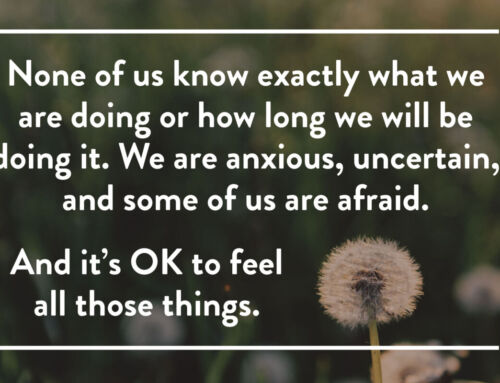By Hailey Shafir, LPCS, LCAS, CCS-I
As a counselor, I often find myself helping clients reframe, or think differently, about their emotions. Many people come to counseling because they are struggling with difficult emotions like sadness, anxiety, or anger and often describe these emotions as “problems” they are hoping to get rid of. The thing is, emotions aren’t problems. An emotion is a collection of thoughts and feelings people experience in response to their circumstances. While they are certainly uncomfortable at times, they aren’t inherently dangerous, and they cannot force you to act.
This is not to say that emotions don’t matter – they do. Emotions are messages about what you care about most. These feelings are powerful because they are meant to get your attention during times when there are things at stake that matter to you. These might include people you love, projects you’ve poured yourself into, dreams for your future, or other core values that are important to you, your life, or your future.
Uncomfortable or difficult emotions like sadness, fear, or anger are part of the “package deal” that comes with being human, the same package that also includes emotions like excitement, joy, and love. The only way to “get rid” of the emotions would be to trade in the entire package, at the direct expense of caring about those people, projects, dreams, and values. Most would be unwilling to make this trade. Still, emotions can be intense and result in a great deal of suffering. You might be wondering if there is anything you can do to reduce this suffering without making this trade. Thankfully, there are some strategies that many people find helpful.
Before I get into those, let’s circle back to the original question, “If emotions aren’t the problem – what is?” Usually, the ‘problem’ is the way people react to their emotions. Those who have described anger as a problem typically have a pattern of lashing out at others when they are angry. Those who have described anxiety as a problem often have a pattern of both rumination and avoidance. They often spend hours worrying about possible adverse outcomes, then avoid situations where these outcomes may occur, even if it means missing out. In both examples, the ‘problem’ is not the emotion, but rather what a person does internally and externally in response to the emotion.
Most people unknowingly give too much power to their emotions by over-focusing on them and letting them drive actions and choices. When painful feelings like sadness show up, you may focus on sad stories from the past or negative thoughts like, “No one cares about me.” Over-focusing on these thoughts and stories will likely make you more depressed, to the point where you shut down, push people away, and stop doing the things you like or need to do. These responses to your sadness probably don’t feel like conscious choices at the time, and many people have operated off the false belief that there are things you have to do when a specific emotion shows up. Examples of this include not going to a party when you feel anxious. Each time you have acted on this false belief that your emotions control your actions, you grant your emotions a little more power. The good news is that when you recognize this pattern and the fact you have a choice, you can begin taking this power back.
In Acceptance and Commitment Therapy, there is a metaphor that emotions should be passengers but not drivers. Treatment focuses on teaching skills to remain in the driver’s seat even during times when there is a loud, unruly, or unpleasant passenger like fear, anger, or sadness. In the driver’s seat, you will be able to make choices and go where you need to, without your emotions controlling your decisions. This does not mean ignoring your feelings, but instead, acknowledging and accepting them. It also means not becoming so distracted by them (i.e., ruminating or over-focusing on them) that you can’t concentrate, miss turns, or get into accidents.
Take back control from your emotions by refocusing your attention, then choosing how you respond. Sometimes, it is better to refocus on a different aspect of what is happening. For instance, instead of thinking about what could go wrong during times when you are anxious, focus on what you could do to feel more prepared, or to control the outcome. Other times, you could choose to bring your focus away from your thoughts altogether. Try using mindfulness techniques to focus on where you are by using your five senses. The key to mindfulness is to bring full awareness and attention to something happening in the here/now, and to keep gently bringing your mind back when it begins to wander.
Once your attention is refocused on something happening in the here/now or some aspect of the situation within your control to change, you are already likely in a better space. When needed, the next step in the process would be to circle back to the emotion and unwrap the message it has for you by asking yourself, “What about this situation matters to me?” Think of things that scare you, upset you, or anger you and try going deeper to identify what about these things matter to you. Our emotions are inextricably linked to our values. People do not tend to have significant emotional reactions to things that don’t matter to them.
Although emotions and values are connected, they often do not lead to the same actions and choices. For example, you might become jealous of how much you love and value your partner and the relationship you have with them, but the words and actions that tend to come from jealousy often damage relationships instead of protecting them. Identifying the value beneath your emotions can help to guide more helpful choices. In this example, the jealous response might be to interrogate your partner or start a fight, which is likely to damage the relationship. In contrast, actions derived from how valuable your partner and your relationship are to you might generate responses like sharing your insecurities, asking for reassurance, or doing things to foster more closeness and trust.
The key takeaway is not to take your emotions at face value, but to see them as messages. Once you understand this, you are able to go deeper to find the message they hold about your values. The next time you experience a strong emotional reaction, take a moment to pause and ask yourself, “What about this matters to me?” When the emotion is particularly strong, you may need to take time beforehand to refocus your attention, using mindfulness techniques to get some distance from the thoughts that might be feeding them. By using these techniques, and sometimes with the support of a counselor, you will find that you can remain in the driver’s seat, even when you have a difficult passenger along for the ride.



